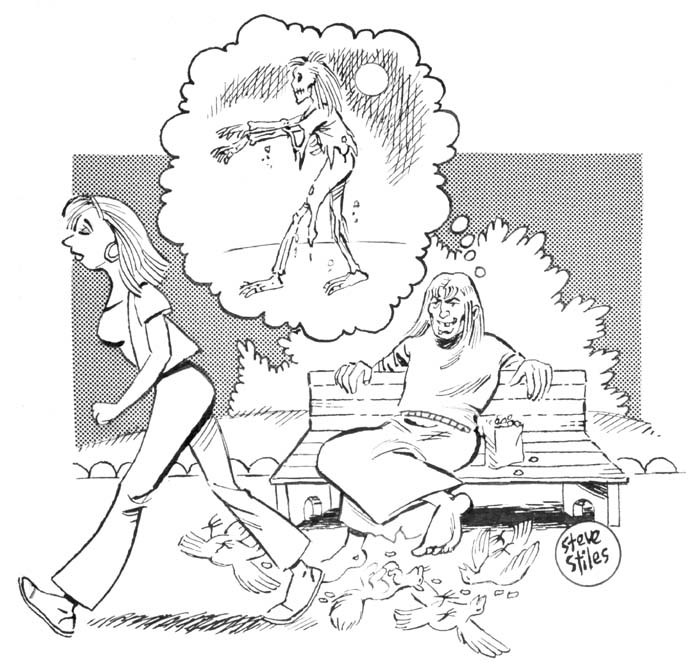

Cover art by Steve Stiles (copyright reverts to him)
Cartoons by Alexis Gilliland and Barry Kent MacKay(copyright reverts to
them)
The Government in Exile by Paul Collins, Sumeria,
Melbourne 1994, 242pp, wraps, $A12.95
My curiosity about the cover price led me to discover that black
broad-tip marker can be removed from coated paper with acetone.
This is a collection of SF stories by the editor of
Metaworlds, a Penguin anthology of Australian SF. Twelve
of the stories are reprinted from assorted magazines, and the
other five are original here. They are well-written, but seem to
describe brief and pointless episodes in a very unpleasant
future. In the large clear portrait on the cover, the author
doesn't look suicidal....
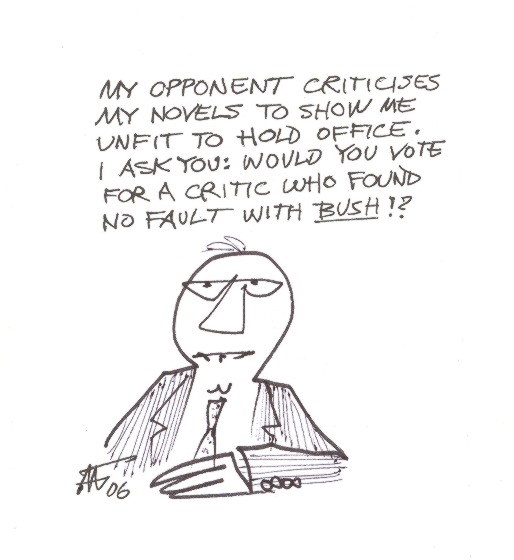
An Intimate Knowledge of the Night by Terry Dowling,
Aphelion, North Adelaide 1995, 285pp, maps, wraps, $A14.95
Another collection - so non-linear that it makes me dizzy. The
introduction seems as mystical as the stories, each of which has
a long afterword that muddies the waters even further. The maps
are dimly printed. As with the Collins book, the cover carries a
photograph of the writer - this one enhanced by a candle whose
smoke forms the image of a naked lady.
Roses of Blood by Jeffrey Johnson-Abdelmalik,
Bluegum/Angus&Robertson/HarperCollins, Sydney 1995, 170pp,
wraps, $A9.95
Bluegum is the "paperbacks for children" imprint, and the cover
photo here is probably not of the writer, as the
dedication indicates that he is married with two children and
the person in the photo looks too young for that - but who
knows.... Besides the relatively low page count, the print is
twice the size of the two previous books - just to make the book
the "right size" I suppose, as it must be aimed at the Young
Adult Horror market and the target audience can probably read
small print better than us old fogies. I remember reading a very
compact edition of The Pickwick Papers as a child, it was
in very small print. But I like short novels, and this one
starts with a bang as a three-masted clipper ship arrives in
Melbourne with a very strange cargo.
Perhaps overly sentimental, and certainly overtly religious, but fast-paced and truly horrific, especially the dark ending.
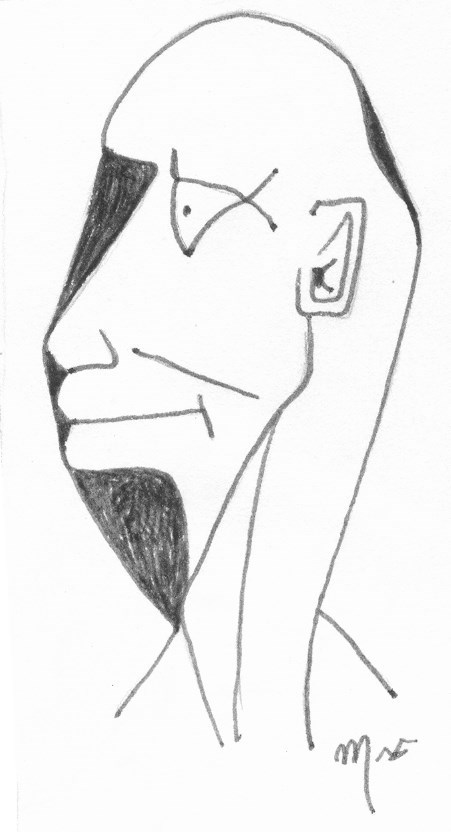
The House of Freeman (ed.Garland E. McBride),"An
Unpublished Poe Manuscript?", Daily Press New Dominion Magazine,
vol.12, no.12, 4/14/74, tabloid
The Daily Press & Times Herald is the local paper in Newport
News VA where I used to live - I think the two papers merged
while I was there (1959-1998). There is an editorial comment
with this piece that it is a rare break with a policy of not
publishing fiction. The story, which is quite short, appears on
pp.6-7, embedded in an article by Garland E. McBride, who
recounts a chance meeting in an airport with an old woman named
Penelope Evans who had a box of Poe manuscripts inherited from
her grandmother. Later she sends him a typescript of this
story.
This may be all smoke and moonbeams, of course - but it does make the magazine a fictionmag, perhaps doubly so if the framing story is fiction as well. I have done a Google search on the key words, but find no online record of the matter.
Poe by Nancy Loewen, Creative Editions 1993, 63pp, photos
by Tina Mucci
This brief biography of Edgar Allan Poe (1809-1849) is
illustrated with atmospheric color photographs - three of which
show a Remington portable typewriter of the 1930s, artfully
displayed on a desk with papers, old books, etc. Were Loewen and
Mucci ignorant - Poe could never have seen any typewriter, much
less this one - or did they think such illos fell within the
limits of their poetic license?
The Owl * The Duck * and - Miss Rowe! Miss Rowe! by John
Cowper Powys, Village Press 1975, 26pp, wraps
Ferociously sentimental and mystical - I was never able to get
into his longer works, probably for that reason. At this length
it is interesting as a look into what must have been a very
strange mind.
Peake Studies, ed. by G Peter Winnington, vol.10, no. 1,
October 2006
This digest-size journal is indispensible to fans of the great
writer/artist Mervyn Peake, offering articles about him and his
works, examples of the drawings, and, in this issue, a
previously unpublished play, Those Wicked Doctors , a farce
in three acts. Two new books about Mervyn Peake appeared in the
fall of 2006 - Mervyn Peake, the Man and His Art was
mentioned in the previous issue of this zine; and I will
probably make an entry on The Voice of the Heart in this
issue. For anyone interested in getting Peake Studies or
the books, there is a contact point at
http://www.peakestudies.com
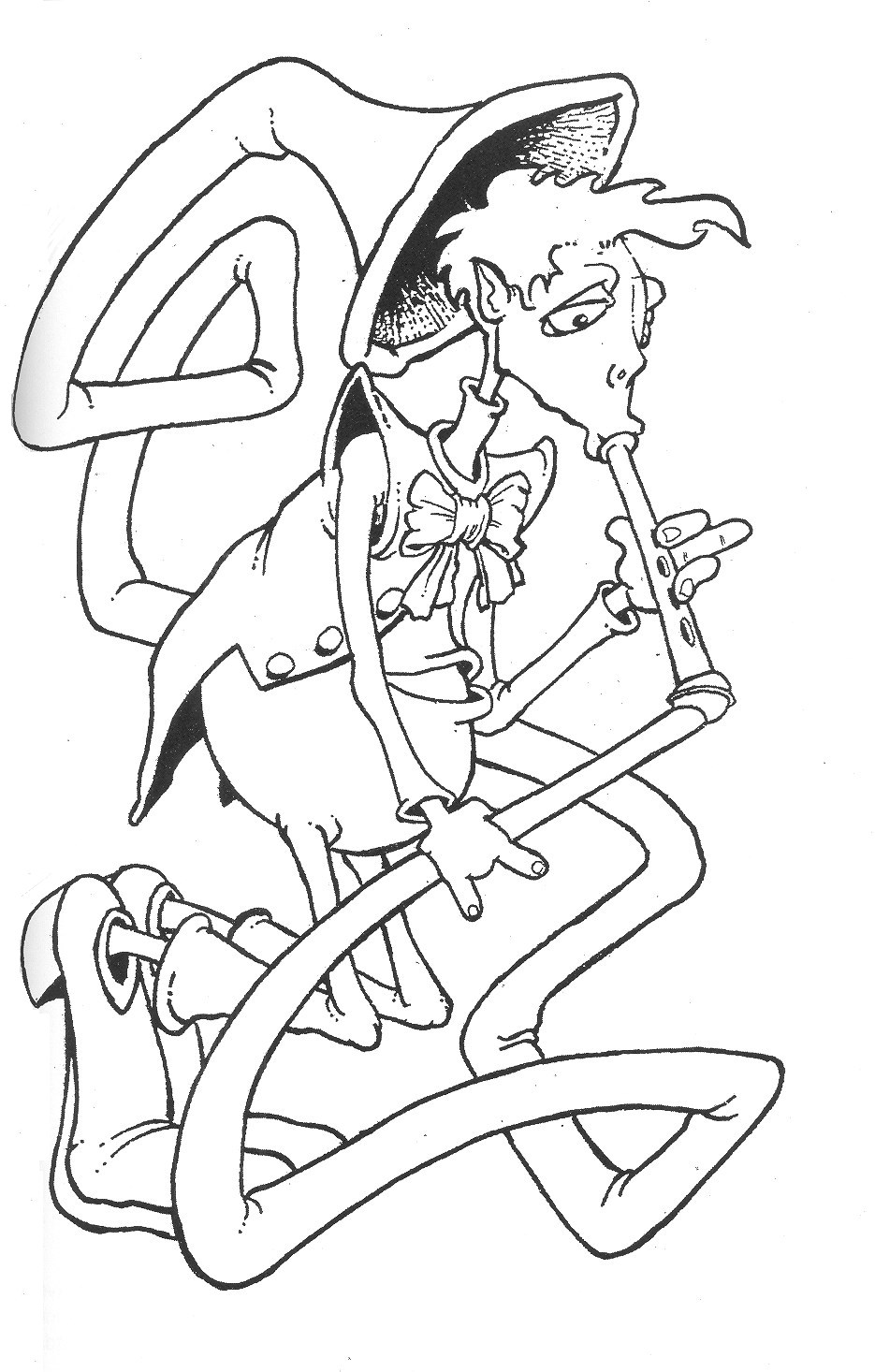
Bellissimo!, ed. by Rob Jackson, 2006, 122pp, $14
Also published by Jackson - a beautiful anthology of the fanzine
art of Harry Bell over the decades, sold to finance a trip for
Harry to the February 2007 Corflu in Austin Texas, with any
surplus funds to go to other fan funds such as TAFF and GUFF.
Ghu only knows whether any copies will be available by the time
this issue of IGOTS appears. I see that Rob wants more data on
where these pieces appeared - the p.21 illo of the man in the
hat in front of the huge chains is from Shipyard Blues 6, April
1991, and must be based on the photo of Isambard Kingdom Brunel
at the 1857 launching of his ship Great Eastern. The photo was
published in THE GREAT IRON SHIP by James Dugan, Harper&Bros
1953, p.113. And Rob didn't use the lovely one that Harry did
for the 8th issue of IGOTS. Rob Jackson might be reached at
Jacksonshambrook@tiscali.co.uk
Cemetery Rose by Leigh Blackmore, Lulu PoD 2006, 30pp,
ills. photos, wraps
I don't understand the logic behind printing a digest-size
booklet in 8-point Ariel double-column - and then double-spacing
the lines. Why not use a larger font and normal line spacing? I
had to read it with my glasses off - fortunately (for this
purpose) I have 20/600 vision. The attempt to flow the text
around photo illustrations almost the width of the column is not
successful - the text becomes almost gibberish as words break at
the line end with no hyphenation. Hard to say whether this (and
a few typos) the fault of the typesetter or of the Lulu
publish-on-demand system.
The story itself is quite well-written and spooky, and the
photos apparently of the actual Rookwood Cemetery in Sydney,
said to be the largest 19th-century cemetery in the world.
There's a nod to Clarence John Laughlin. I didn't get to see
this cemetery when I was in Sydney in 1975, but I do have a
color photo of the Mortuary Station (where coffins were brought
in by rail) that was removed to Canberra to be a church. For
more information, see -
http://members.optusnet.com.au/lvxnox/
Hermetic Horrors: Weird Fiction Writers & the Order
of the
Golden Dawn by Leigh Blackmore, Lulu PoD 2006, 24pp, ills.
photos, bibliography, notes, wraps
Here - as with the previous booklet - the text is just as small.
But the space is used efficiently, and with the single-column
layout, flows around the graphics much better, though there are
still glitches. The cover designer managed to lose both the
colon and the final word "Dawn"!
This article first appeared in Shadowplay 14 in 1987, and again in Sirius 7 in 1994, and can be found online at the shadowplayzine site. The title seems a little overly sensational to me, as relatively few horror writers belonged to the Golden Dawn; and the writings of the members that I am familiar with are not particularly horrible. The most noted horror writer to have been a member must have been Arthur Machen.
More writers I have read were apparently members than I had realized, however - William Butler Yeats (not noted for horror!), Algernon Blackwood, Sax Rohmer, and Bram Stoker (all arguably horror writers). The rest of the authors mentioned are neither horror writers not members of the Golden Dawn except in the imaginations of Les Daniels and Philip Shreffler. But if you have a magnifying glass - or am as nearsighted as I am - this is an interesting look at the writers of the late 1800s.
The Clerkenwell Tales by Peter Ackroyd, Doubleday 2004,
213pp, notes, d/w $24.95
Fortunately this book was too good to sell well and I got it at
a large discount from the Dedalus catalog! Each chapter is a
different character's view of the curious events taking place in
London, tangential to Henry Bolingbroke's seizure of the throne
from Richard II in 1399. The last chapter is actually Ackroyd's
notes on the period. Beautifully written and mysterious - I
enjoyed it a lot.
Mineshaft 19, ed. Gioia Palmieri & Everett Rand, 56pp
digest-size, tri-annual (more or less), $6.95 or 3/$18.50.
They get art and letters from Robert Crumb, and print them
beautifully. Andrei Codrescu is in this issue as well.
The Doomsday Book by J. MacLaren-Ross, Ivan Obolensky, New
York 1961, 182pp.
A thrift-store find - silly plot, but it moves right along.
Apparently written for radio - at least it is dedicated to
people who "helped to bring these characters to life on Sound
Radio". I never heard of Sound Radio - except for archaic Morse
Code messages, most radio seems to be "sound" radio! It would
have made a good B-movie. Not overtly fantasy, but as unlikely
as most fantasy!
Grey by Jon Armstrong, Night Shade Books 2007, 239pp,
wraps
An "Advance Uncorrected Proof" review copy. I should stick to
old books I suppose, this is not my cup of tea. It reminds me of
the infamous American Psycho in the endless details of
unlikely food and fashion. Unlike that book, it is skiffy, set
in some undefined future. The flavor of the thing is exemplified
by the "fried whale and plum sandwich" that the hero is eating
in the opening sentence and the endless mix of common (fucking
this and fucking that) and exotic (raccoon rectum) profanity
that laces the dialog.
Comics Revue 250, ed. Rick Norwood & Don Markstein, 68pp,
wraps, $6.95
And in an editorial Rick notes that this is their 250th
consecutive monthly issue! Rick kindly sent me this one because
the cover is from his original Vaughn Bode art, a drawing of
"The Man" that Vaughn gave him in 1966 in trade for a stack of Alley
Oop strips.
This issue reprints eleven strips dating from 1937 to 1979,
three of them in color. It's been a long time since I saw Alley
Oop! The website is -
http://www.io.com/~norwoodr
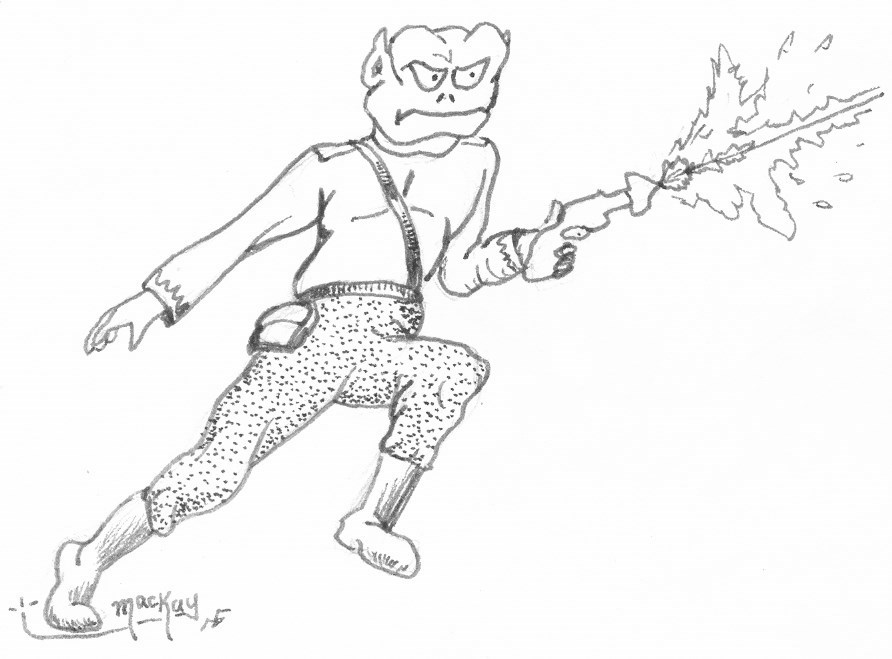
Brave New Words ed. by Jeff Prucher, Oxford University
Press 2007, 342pp, bibliographies, $29.95
In spite of the title pun they used as dust-jacket art an Alvim
Correa illo from a 1906 edition of War of the Worlds. This
is subtitled The Oxford Dictionary of Science Fiction - in
the modern tradition of outsourcing, they note that Prucher is a
"freelance lexicographer"!
Both science-fiction and SF-fandom words are included. They consulted Fancyclopedia and Fancyclopedia II. But they don't include all fannish jargon - faunch is missing, and propellor beanie, and crottled greeps, probably others I haven't thought to look for yet. It is a valuable reference however, done in the style of the Oxford English Dictionary - that is, each entry is supported by a dated published source. The word fanzine, for example, is traced to a 1940 Detours by Russ Chauvenet - unfortunately they quote him as proposing "fanzine" to replace "the un-euphonious word `fanag'". I don't have that source on hand, but if it actually has the word "fanag" it was a typo - the older usage was "fanmag".
They trace the much-debated "little green men" to a story in the October 1946 Weird Tales.
Ravens of Avalon by Diana L. Paxson, Viking 2007,
xvi+394pp, map, glossary, $25.95
The price is that of the projected August 2007 edition - here in May I
have the paperback Advance Review Copy, thanks to Kevin Che. The
actual title may be "Marion Zimmer Bradley's Ravens of
Avalon". MZB died in 1999, and Diana Paxson completed this
Avalon book from the material that she left. A previous Paxson
book in the series was the 2004 Ancestors of Avalon.
My feeling is that this sort of historical fantasy should be illustrated.... MZB seems to have done a lot of research as the basis for this tale set in the Britain of 2000 years ago - the 8-page glossary of names says that most of them were found in documents of the era. There is a map with place names but no roads - though the routes of the durable Roman roads of the time must be fairly well known.
The tale is told as a memoir by the Druid priestess Lhiannon, who lives through the Roman conquest. The prose style is excellent, if perhaps a little over-burdened with factoids left over from the research.
Shadow Coast by Philip Haldeman, Hippocampus Press 2007,
255pp, wraps, $15.00
Derrick Hussey sent this complimentary copy of a recent
Hippocampus book - see
http://www.hippocampuspress.com
The rather Lovecraftian story is set in the Olympic Peninsula
area of Washington state and loosely based on native American
myths - the sea creature Sisiutl "captures the souls of the
untimely dead". Alas, the prose is plebian to awkward - the
phrase on the first page about a face that "demanded authority"
just made me giggle in remembrance of Eric Cartman's immortal
cry "Respect my authori-tie!". Those who know something about
sailing may like it.
Pig World by Charles W. Runyon, Doubleday 1971, 215pp, $4.95
Someone on the "fictionmags" Yahoo-group list brought up
this novel of the previous millennium, which I see has actual
cloth over the boards of the binding. The dust-jacket art by Jan
Faust is even uglier than the full-length portrait of the author
on the back - a picture of a pig that has either been eaten by
or has turned into a thorny bush. Well-rendered line art
though!
The text, which I somehow missed at the time even though I was collecting such examples of bad sf as Galaxy 666 and Queen Kong, is a perhaps prophetic account of the USA envisioned by King George Dubya where dissenters to the decider are tortured and murdered - but interlarded with pointless sexual imagery whenever any woman enters the scene, whether or not she has anything to do with the plot.
Alice in Wonderland by Lewis Carroll, published by
Progress Publishers, Moscow 1979, 236pp, illus. by ???
The actual text (which starts on p.35) and the title on the
binding and title page are in English. But the colophon, the
22-page introduction, and the 59-page glossary at the back are
all in the Cyrillic alphabet. The ivory cloth binding is
stamped in red and black with a design by the same artist as
did the elaborate 2-color interior art, while the endpaper art
appears to be by a different hand. There may never have been a
dust-jacket, as what appears to be the price is stamped into the
binding on the back cover - "1p.30k.", but as this is also
Cyrillic, the "p" is probably an "r" and the "k" a hard "c". The
initials "CCCP" appear twice in the fine print on the last page,
so I suppose this was a production of the old U.S.S.R.
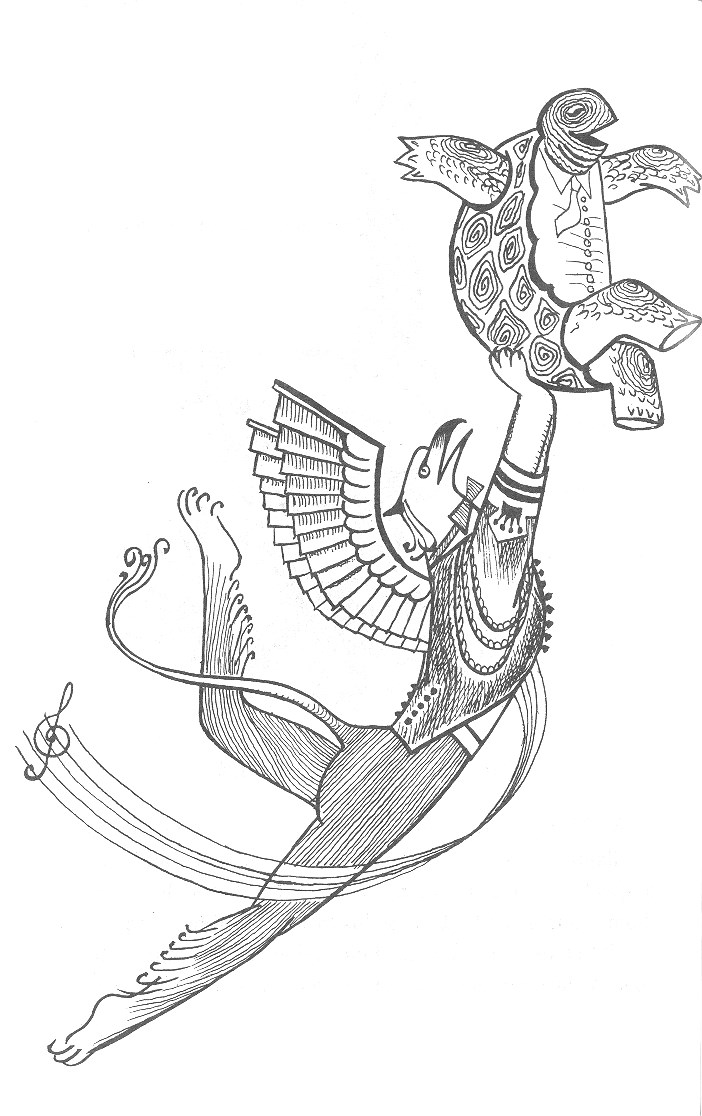
Phlizz #1 (May 2007), ed. by Chuck Connor
(fruggles@boople.force9.co.uk; 64 Chelwood Avenue, Hatfield
HERTS, AL10 0RE, England)
A fanzine in HTML and PDF on an 8mm CD-RW - I didn't even know
that my CD drive would read a mini-disc (the more common CD is
12mm) but when I looked, sure enough there is an 8mm recess
inside the 12mm recess of the drive tray. The disc plays
perfectly, and has excellent fonts and layout. The disc and case
weigh just under an ounce, but with the cover sheet and envelope
the total weight is just over an ounce and was mailed from
England airmail. And interesting alternative as a
paper zine with the same color printing would have cost a
fortune to print and mail.
Chuck even suggests that it could be recycled - that is, you
could copy the contents to your hard drive and use the
rewriteable disc to send him a LoC or contribution - there would
be plenty of space, as the disc holds 193 megabytes. But of
course he has created a collectible, if one that does not match
any corner of my fanzine filing system! The case for the disc
even has a picture of him (I suppose) as Admiral Connor, setting
sail on the seas of fandom. Perhaps he couldn't find an
Admiral's uniform, the figure seems to be wearing the costume of
a 19th century midshipman or seaman. Nor do I know what "phlizz"
means, or even how it is supposed to be pronounced. He last
appeared in my fanzine index with the 1990s issues of
Thingummybob.
Phlizz #2 appeared in August.
Gatesways to Forever by Mike Ashley, Liverpool University
Press 2007, 507pp, chronology, tables, appendices, bibliography,
index, 50 pounds
I think this must be the most expensive complimentary copy
anyone ever sent me, nearly $100! It's Volume III of his
Story of the Science-Fiction Magazines, covering the years
1970-1980 (previous volumes were Time Machines, through
1950, and Transformations, 1950-1970). There is a
paperback edition at 19.99 pounds. I see that I get into the
Acknowledgements pages as having sent him some fanzine scans.
A large well-made book, with a amazingly detailed account of the magazines of the 1970s - circulation figures, cover artists, editors, publishers, dates and issue numbers. The types of stories are discussed in relation to the society that bought them. It covers not only the newstand magazines, but things as obscure as Meade Frierson's 1000-copy H.P.L. oneshot, and includes details like the origin of the title "Quark", which appeared as a crow-noise in James Joyce and as a sub-atomic particle name before its use as the title of an original anthology series. He fails to note that it was also the title of two fanzines in the 1960s - but of course you have to stop somewhere!
Living Alone by Stella Benson, Macmillan 1935, 264pp
I had one Stella Benson book I had never read, and got this one
because of comments about it on the "fictionmags" Netlist.
It originally appeared in 1919, and is set in London during WWI.
The plot is disjointed and silly, but the characters and the use
of exotic metaphors make it fun to read. Definitely a fantasy,
as the main character is a witch with a broomstick named
Harold.
Travels With C. S. Lewis (Day One 2006) and The Backward
Glance (Institute of Irish Studies 1999) by Ronald W.
Bresland, 128pp/140pp, photos, maps, index, both wraps.
Ronald Bresland is at the Queen's University of Belfast and sent
me these autographed copies of his books in thanks for some text
scans.
The "Travel" book, all on coated paper, is copiously illustrated with photos old and new, maps, postage stamp images, stained glass - and very well written too, I enjoyed it. The Backward Glance has an extensive index and a chronology and is a detailed account of Lewis' connection with Ireland - much of his childhood was spent at Glenmachan House in Belfast.
Alice in Sunderland by Bryan Talbot, Dark Horse Books
2007, 324pp, $29.95
I have only seen a few "graphic novels" that held my interest.
This large (8x11) hardcover is in the graphic novel style, but
would have to be called a history or documentary. I found it
fascinating, though so ponderous that it has to be read at a
table. It's "about" the region of NE England called Sunderland
and its connection with Lewis Carroll and the Alice books.
An excellent illustrated version of Jabberwocky is
included. And long-time correspondent Ruth Berman is listed in
the acknowledgements as a Carrollian scholar!
Pippin's Journal by Rohan O'Grady, Panther (1788) 1964
wraps 3/6
And illustrated by Edward Gorey, which is why I got it. The
cover is not by Gorey and seems to be uncredited. "Rohan
O'Grady" is a pseudonym for June Skinner, and the Gorey art was
probably done for a Macmillan hardcover that I have never seen.
The text has also been published as Rosemary is for
Remembrance.
I enjoyed this tale of a teenage girl who falls in with (and outsmarts) some thugs in a wild corner of England at some unspecified pre-electric but post-colonial period - reminds me a little of Treasure Island. The blurb hints that there is a supernatural element, but I don't remember seeing it. I see that it was given to me by Rog' Pile, who lives in Cornwall.
Trap Door 24 (Jan'07) ed. Robert Lichtman
(locs2trapdoor@yahoo.com)
Excellent fanzine - Steve Stiles cover, Grant Canfield memoir,
Mike Dobson on computer-enhanced artistry, Gregg Calkins on Bob
Tucker - somewhere I have a book that Phil Harrell got from
Gregg Calkins over 40 years ago.
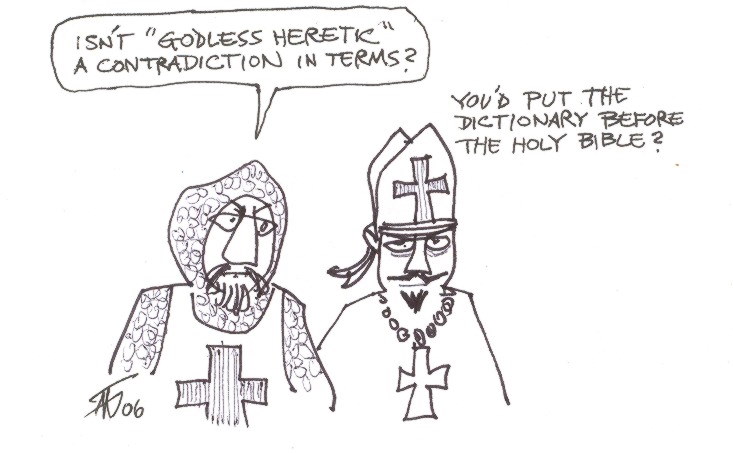
Ah! Sweet Laney! ed. Robert Lichtman, Corflu Quire 2007,
128pp, ills divers, wraps
Just what I paid for this and how many they made I have no idea
- you could e-mail Lichtman, see previous entry. "Corflu Quire"
is a convention, held in Austin TX in 2007, but I wasn't there.
A beautifully laid-out and printed memorial to the famous
1940s-50s fan Francis Towner Laney. The binding is something
new, a rigid plastic spine and glassine covers wrapped around
the stack of standard-size printed sheets. Besides Laney's own
writing, there are pieces about him by Charles Burbee, Bob
Bloch, and Jack Speer. The cover is a Virgil Partch caricature,
and several fanzine covers are reprinted.
The price for it is $15 plus postage (depending on where you live). The layout, printing and binding was all
done by Pat Virzi, who has all the for-sale copies, and who can be reached at virzi (at) swbell.net. There's also
information about it on efanzines.com. [Post-publication cyber insert!]
Filthy Creations
I don't see a price, but the address is the same as Roger Piles
and an e-mail address and website are given -
filthy_creations@yahoo.co.uk
http://www.vaultofevil.suddenlaunch3.com
A nicely produced anthology, with a good color cover on coated paper. Good art. There are six stories by five authors, or an author whose name is not given. Good horror tales. There is no indication that this is the first issue of a magazine rather than an anthology.
The Generation of Prime Numbers by Osric Allen, Robert
Temple 2006, 16pp, notes, wraps
The publisher kindly sent me this because of the "prime number
equation" in IGOTS 28. I quoted that gruesome equation without
understanding how it was devised - and the mathematician who
devised it did not claim that it was useful! Osric Allen wrote
his little book to differ with the majority of mathematicians in
the field who say that there is no regular pattern or equation
for the primes.
Allen attacks the very definition of "prime number" by declaring -1 the first prime and dropping 2 and 3. He then generates the series by starting with -1 and adding 2 and 4 alternately - this series contains - he says - all the primes and all the multiples of primes. Except, of course, 2, 3, and their multiples. This series does contain all the primes below 300, but he presents no proof that the infinite series would indeed contain all the primes. He then begins to set up tables showing that the multiples in this series form a series of patterns by which they could be removed, leaving only the primes. But even if all the primes are in that series, it seems to me that the number of patterns needed to remove all the multiples would increase without limit.
But he mentions the Riemann Hypothesis, so he's probably smarter than I am....
LOCs, ed. by Brad Foster, Jabberwocky Graphix 2007, 28pp,
illus. divers
About the same mini-size as the previous entry! But here, except
for the colophon and art credits pages, each of the rest is
devoted to a cartoon by one of the fan-artists who contributed.
Most of the usual suspects are here, and some I had not heard of
- I don't know who "Sherlock" is, but his work looks a lot like
that of Ron Cobb. At least ten of them have given me artwork!
Speaking of which, I hear that Montreal has won the 2009 WorldCon, and Taral is to be Fan GoH!
No price or print-run is mentioned - but Brad (Jabberwocky Graphix is easily found online) tells me that it is available for $2 including postage .
The Illustrious Dunderheads by Rex Stout, Knopf 1942,
194pp, illus. William Gropper
An odd sort of political commentary. After a chapter on the
perceived aims of Nazi propaganda, we get a short chapter each
on 145 Congressmen and 28 Senators, giving their voting records
on certain specified bills and their statements - though some
seem to have been mute. And this is all illuminated with
political cartoons by Gropper - no mention of whether they are
reprints from newspapers. I probably bought the book for the
cartoons.
The only one of these "dunderheads" - Stout seems to be down on them as being insufficiently eager for WWII - that survived for me to remember seeing their names in the paper is Everett Dirksen.
The Voice of the Heart by G. Peter Winnington, Liverpool
University 2006, 290pp, illus. Mervyn Peake, index, 50 pounds
This is subtitled "the working of Mervyn Peake's imagination"
and is by the editor of the long-running magazine Peake
Studies.
There are about 50 b&w plates, but the very detailed commentary is on Peake's entire body of work - the art, the novels, the poems, the plays, the handful of short stories.
The Trial of John Donald Merrett ed. by William Roughead,
William Hodge 1929, 326pp, foldout diagram, photos
Interesting criminal proceedings in England were recorded in a
series of books called "Notable British Trials". This case
was apparently quite complex and went on over a week - all of
the testimony and lawyers argument are given. Shorthand and
firearms testimony are involved. Merrett was accused of shooting
his mother in the head with an automatic and forging checks on
her bank account. He was convicted only of the forgery, and
sentenced to 12 months.
A search at Google reveals that in 1954 he killed his wife and mother-in-law for their money....
Discovering the Golden Compass by George Beahm, Hampton
Roads Publishing 2007, 208pp, illustrated by Tim Kirk,
appendices, index, wraps, $16.95
This "Guide to Philip Pullman's Dark Materials" was given to me
by the author, who blames me for leading him into book
publishing.... It includes interviews with Pullman, a chronology
(he was born in 1946 - I'm still not used to thinking of writers
being younger than I am - but there is only one small photo and
he looks older!), excellent artwork by Tim Kirk, detailed
commentary on the stories (which, alas, I have yet to read) and
photographs of locales and artifacts (from a stage version).
The Maid with Wings by E. B. Osborn, John Lane 1917, 263pp
The title page refers to the 19 pieces in this book as
"fantasies grave and gay" while the next page thanks the
Morning Post for allowing reprinting of "a number of these
essays in the irony of circumstance". Arthur Machen wrote some
things that lie in a similar misty hinderland of literature!
In the title piece, a wounded English soldier (a WWI sniper) is visited on the battlefield by Joan of Arc - so I suppose this could be called a fantasy essay. Very good too. The rest of the book is a mixed bag - a very turgid play set in Hell, a scene at the gate to Heaven that reminds me a bit of Lord Dunsany. Dead or dying soldiers seem to be a popular theme. There are also two silly "westerns", a futuristic cricket match, and a comedy about a world championship boxing match with a rather prophetic "Million-pound" purse. There is an account of the replacement of the chair with Turkish ottomans, and one about a Shakespearean actor who becomes allergic to iambic pentameter - I know how he felt. At my first Worldcon there was a fan who insisted on reciting ad nauseam his compositions in rhymed iambic pentameter - I wonder if he still survives. His name was Haughey I think, and I never heard of him in any other fanac.
Man in the Holocene by Max Frisch (trans. from the German
by Geoffrey Skelton), Harcourt Brace Jovanovitch 1979, 112pp,
ills.divers
The "holocene" of the title is the geological term for the
current era. And though the "man" in the title sounds generic,
the original German title Der Mensch erscheint im
Holozen seems to mean "the man appears in the Holocene" -
if the author had meant "mankind" he would have used "Menschen".
In any case, there is only one man in the story, an elderly man
of unsound mind isolated in a remote alpine valley by a bridge
collapse and winter weather. The book is illustrated with the
book and newspaper clippings that the man obsessively cuts out
and tries to stick to the walls. A very curious thing to read -
and fortunately quite short.
Tremendous Trifles by G. K. Chesterton, Dover 2007, 216pp,
wraps, $9.95
A collection of columns from the Daily News , originally
published in 1909. The author had a fondness for paradoxes, and
could tell a good tale! I enjoyed these 38 short pieces a lot.
With the Night Mail by Rudyard Kipling, Doubleday Page
1909, 77pp, illus by Frank X. Leyendecker & H. Reuterdahl
This well-known science-fiction story is set on a mail
dirigible. It's subtitled A Story of 2000 A.D. and was
apparently so popular in the magazine version that they had to
do a book. It was a strain to get enough text to look like a
book, so they printed only on the front of the sheets and
included "extracts from the contemporary magazine in which it
appeared" (McClure's Magazine, Nov. 1905 - but the
reference must be to some imaginary magazine of the year 2000).
The art (four color plates and a color endpaper) is excellent
but could have been better printed. The binding is a beautiful
gold and silver design on dark green cloth.
The "extracts" consist of an "Aerial Board of Control Bulletin", of technical advisories and brief reports on 6 crashes and 9 ships missing - in one week! There are invented materials like "xylonite" and a mysterious references to a wrecked ship being "pithed". Perhaps this refers to a bouy being left to mark where a dirigible sank in the ocean. Then there are "Notes" on such things as High Level Sleet and Bat-Boat Racing. The section of "Correspondence" seems rather silly, with a letter by a Prof. J. Vincent Matthews complaining of Transylvanian tourists firing pyrotechnics that produced "violent electric derangements" and ruined the calibration of his compasses. The "Answers to Correspondents" are if anything even sillier, what with the "Laws of Auroral Derangements" by which the magnetic field near the Poles causes electric engines to "seize up". There is a remark that "war, as a paying concern, ceased in 1967"; and that the "Convention of London expressly reserves to every nation the right of waging war so long as it does not interfere with the world's traffic"! There is a Review of a biography of Xavier Lavalle, who compiled the Tellurionical Records - this ends with "to be continued". In the back are a series of advertisements. Many books of the time carried publisher's catalogs in the back, but these are fake ads from the imaginary magazine of 2000 - classified ads for jobs, technical books in the field, and special equipment. The "High Level Flicker" offered by Hansen seems to be a suit "with tweed or cheviot surface" that "cannot be distinquished from the ordinary suit until inflated", apparently some sort of safety gear. Synthetical Mineral Bearings! A used Bat-Boat dealer in Southampton offers "sound wholesome knockabout boats" - these seem to be around 40 feet long with a cruising speed of about 50 knots - price not given.
The Outsider & Others , by H. P. Lovecraft, Arkham House
1939, pp.xiv/553, d/w $5
The famous first Arkham House book, one of 1200, in the Virgil
Finlay dustjacket. I had read all the stories in it of course,
but I had never actually handled a copy. This one was sent to me
by Tom Cockcroft in New Zealand, so it is well travelled!
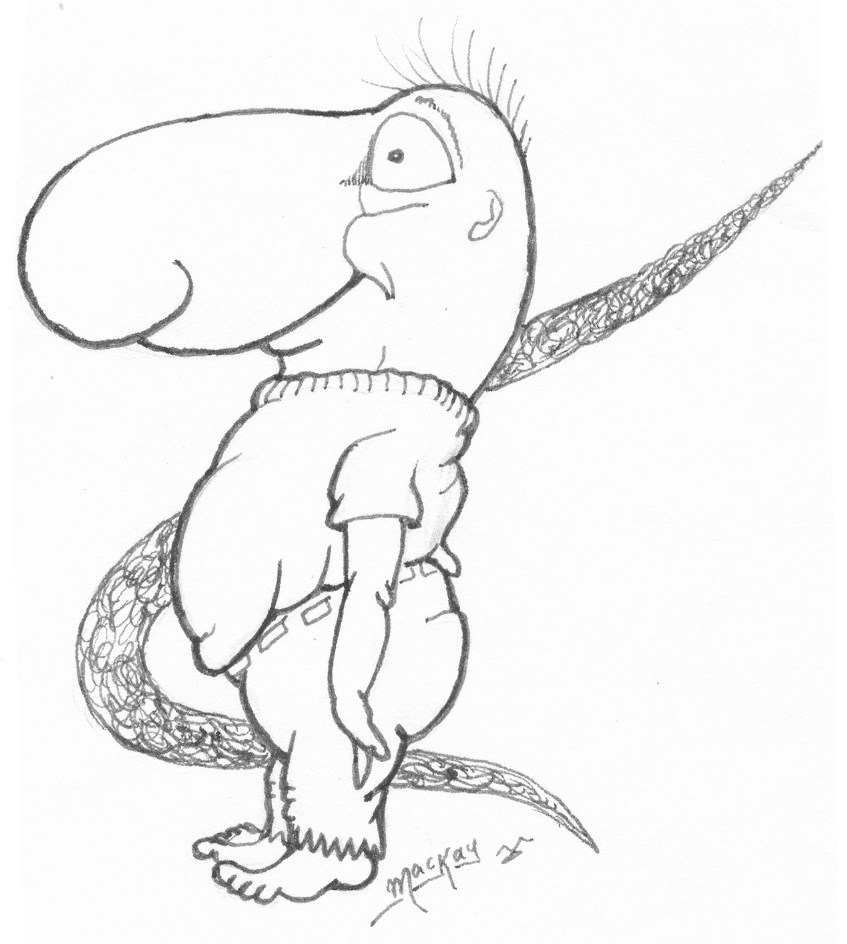
Thursbitch by Alan Garner, Vintage 2004, 158pp, wraps
16.99 pounds
A very atmospheric and mysterious short novel. I enjoyed it a
lot, though there is no glossary so I had to guess at what seems
to be 18th-century rural jargon from the British county of
Cheshire. The other half of the story is contemporary and the
action alternates chapters. By the end I was sure that
"Thursbitch" is the name of a valley, not connected in any
way with the day of the week or the female dog. The principal
18th-century character is Jack, a "jagger" or travelling pack
man, that is, a trader. Jack is also the high priest of a
curious pagan cult that involves snakes, bees, and a bull.
Shadows Seen & Unseen by Clark Ashton Smith, HIH Art
Studio 2007, 94pp, illus. by author and editor and others,
photos, d/w, $28.75
An odd production, printed in China on coated paper with a
pictorial binding and the same art on the d/w. The
Editor/Publisher is Raymond L. F. Johnson, and "fractal images"
are credited to Ardath Winterowd. Both the binding and the d/w
carry an unlikely "25-cent" price in two places.
An odd assembly of CAS items - reprinted biographies - including his own one-page autobiography from a 1936 fanzine, interviews with people who knew him, processed photo overlays.... The painted-over fractal images seem out of place. There are 50 pages of facsimile images of typescript verse. Two short stories The Devotee of Evil and Genius Loci are from the Arkham House collections.
As Green as Emeraude by Margo Skinner, Dawn Heron Press
1990, 92pp, wraps, $15.00
This is a small collection of verse by Fritz Leiber's wife,
done in a signed numbered edition of 500 - it's signed by the
author, Leiber, and Donald Sidney-Fryer, who arranged for the
publication.
Margo Skinner, who is said here in the introduction by Fritz Leiber to have Sioux ancestry, was also a film critic in India. The verse seems to be laboriously designed to avoid either rhyme or rhythm!
Harrison Country by Steve Stiles, TAFF 2006, 34pp,
illustrated by the author, wraps
In 1968 - about the time I first met him - Steve won the
Trans-Atlantic Fan Fund election and travelled to England, where
he met British fans and attended the EasterCon. As they explain
here, TAFF sends a US fan to the UK and a UK fan to the US in
alternate years, and the recipient of the honor is determined by
votes of those who contribute to the fund. But another
requirement is that the winner write a report on his trip for
publication by TAFF. Apparently there is no time limit specified
for this task. Reminds me of the mock trials held at conventions
by the True Faith of the Sacred Cat (Hail Lord Mota!),
where the accused is always convicted, and the sentence is that
he drink himself to death - no time limit specified.
Steve either has a remarkable memory or took good notes 38
years ago.... Or maybe he just made it all up. But it's a
well-written and entertaining account. There is also a Goon Show
pastiche and a Tearaw Tales cartoon strip. Contact -
http://taff.org.uk
The Black Abbot of Puthuum by Clark Ashton Smith, The RAS
Press 2007, 40pp, illustrated by Virgil Finlay, Limited to 250
numbered copies, wraps, $49.95
Gavin Smith, that silver-tongued devil, talked me into this at a
20% discount. It's a reprint from the March 1936 Weird
Tales with the original Finlay art tipped in - not very
typical Finlay, and in sepia tones. But this is the original
text, which was severely cut for the Weird Tales
appearance.
The RAS Press (Terence A. McVicker, 1745 W. Kenneth Road, Glendale CA 91201-1451) was the imprint of the late Roy A. Squires from 1961 to 1987, and has been revived by Terence McVicker on the 20th anniversary. And this book is very much in the Squires style, though I don't think Squires ever used that heavily coated a paper stock.
An excellent tale, with only two typographical errors that I spotted - one might have been Klarkash-ton's own, but the other not.
The Brief Wondrous Life of Oscar Wao by Junot Diaz,
Penguin/Riverhead 2007, 333pp, wraps
This is an advance review copy (uncorrected proof) passed on to
me by Gordon van Gelder. It includes the ephemera that comes
with such books, such as an interview with the author, where he
insists that his first book Drown is neither a novel nor a
collection but something in between. His own idea about "Oscar
Wao" is that it is a "Dominican" (by which he means Dominican
Republic) version of the legend of the "cursed House of Atreus".
The blurb on the back of the book says it will also be a Penguin
Audio book.
The introduction has a lot of Dominican slang and a brief (but
more than I knew) history of the Dominican Republic, which
shares the island Hispanola about 50/50 with Haiti; and explains
the belief in "fuku", a sort of universal curse. I had no
way of knowing whether "Taino" and "fuku" and
other jargon words were historical or made up for the purpose of
using them in a novel - especially since the author is a Tolkien
fan! A search with Google produces a curious result - most hits
just loop back to discussion of this book, but one, an
apparently legitimate website
http://www.kacike.org/FerbelEnglish.html
has a long discussion by Dr. P. J. Ferbel on the Taino, who were
the original native inhabitants of the area. They are now
extinct as a race - because of intermarriage with Europeans and
African slaves - but remnants of their language and culture
remain - among them, "fuku" and the protective
counterspell "zafa".
Like the introduction, the novel itself uses copious footnotes; and it is obvious that while it is written in English, that was not the author's original language. So the style takes some getting used to. If I didn't know Spanish I would be pretty much lost, but even so there is a lot of jargon that is obscure to me.
The most notable thing about the prose to a fan is that the author has obviously read a lot of science fiction and comic books. His description of the gruesome political situation in the Dominican Republic in the days of Trujillo is full of metaphors from The Lord of the Rings. The story itself seems fantastic, set in a social milieu that is almost as alien to me as that of Middle Earth.
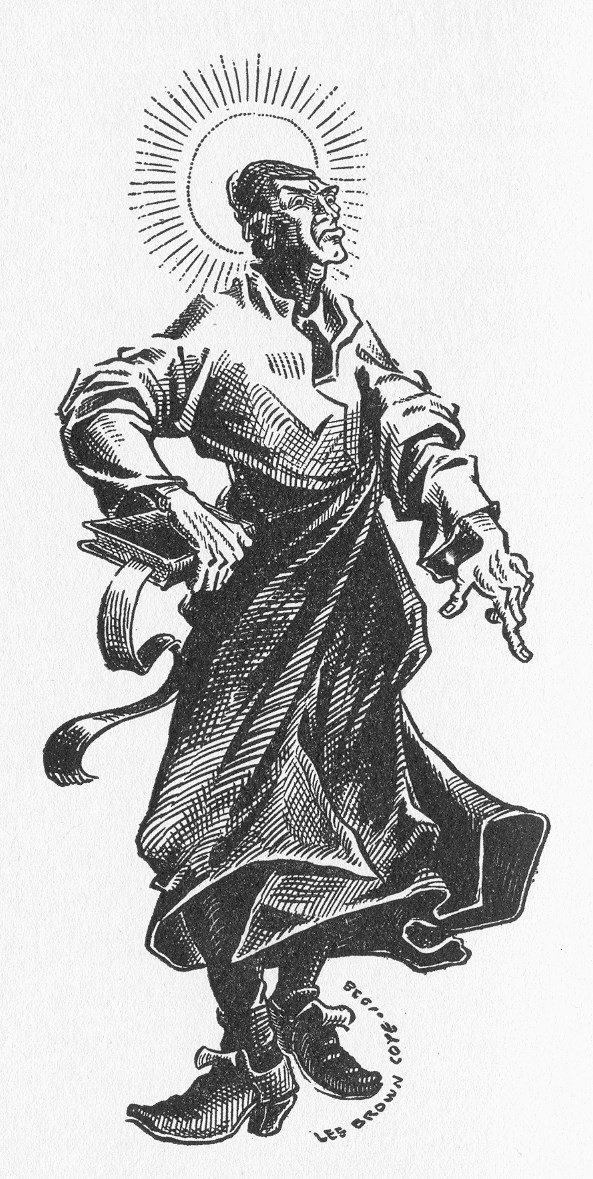
The Art of Bundling by Dana Doten, Countryman Press /
Farrar & Rinehart 1938, 190pp, illustrated by Lee Brown Coye,
d/w $2.50
I had forgotten that I had this book, now (like myself) almost
70 years old, and found it while doing an inventory of the
non-fiction. Some of the illustrations from it appeared in Luis
Ortiz's fine book about Lee Brown Coye (Arts Unknown, Nonstop
Press 2005).
"Bundling" was an odd custom among the early settlers of New England, where a man and a woman would carry out their courting in bed - but fully clothed. It was probably created by the desire for privacy and the need for warmth - in many early dwellings only the main room had any heat from the large fireplace.
This account includes a playlet (called a "Dialogue"), poems about the practice (including one "against bundling"), legal cases; and of course the excellent Coye art.
Julius Henry (Hank) Reinhardt (January 18, 1934 - October 30, 2007) passed away from complications of a quintuple bypass operation. He was a larger-than-life figure in southern fandom, and in the Society for Creative Anachronism , where his persona was Ulric of Wolfhaven. He was also one of the luminaries of the Southern Fandom Press Alliance, and of the DeepSouthCon and the Southern Fandom Confederation.
Hank had worked as a private investigator and as an insurance investigator, and became wealthy through Museum Replicas, a company that sold replicas of historic and fantasy weapons. He leaves two daughters from his first marriage, and after his wife died in an automobile accident, he married Toni Weisskopf, who had grown up in southern fandom and was also a longtime SFPA member.
I first met Hank sometime in the 1960s and saw him often at conventions and through his writing in SFPA. I was in his home many times, and admired his enormous collection of antique weapons. He was a good friend.
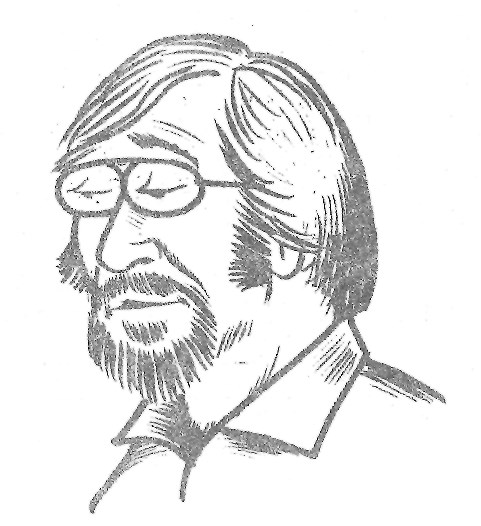
American Esperanto Magazine V.73 No.3 (October 1960),
ed.Doris T Connor, 16pp
This digest-size magazine was among
the fanzines that George Wells has been sending me. In light of
the recent news that Longfellow's poem Hiawatha was
written very much in imitation of the Finnish Kalevala, I
was interested to see that Ernest G. Dodge had dragged it into
Esperanto. Alas, this issue contains only parts III and IV - I
would have liked to see the beginning, which I must have
memorized as a child and can still remember - "By the shores of
Gitche Gumee / By the shining Big-Sea-Water, etc".
But looking into The Complete Poetical Works of Henry Wadsworth Longfellow (Houghton Mifflin 1902 with 270 illustrations) I see that I have been deceived all these years - the lines I remember appear not at the beginning, but in the middle of part III, so I can compare them with the Esperanto translation.
By the shores of Gitche Gumee,
By the shining Big-Sea-Water,
Stood the wigwam of Nokomis,
Daughter of the Moon, Nokomis.
Dark behind it rose the forest,
Rose the black and gloomy pine-trees,
Rose the firs with cones upon them;
Bright before it beat the water,
Beat the clear and sunny water,
Beat the shining Big-Sea-Water.
Ce la rand' de Gice-Gumi,
Ce la brila Grandma-Akvo,
La vigvamo de Nokomis,
La filino de la Luno.
Staris nigre kaj nobombre,
Staris inter la pinarboj
Kaj la trunkoj de abioj,
Hela ce gi akvo ondis,
Ondis clara, sunlumita,
Ondis brila Grandmar-Akvo.
The annoying terminal "j" in Esperanto is apparently
pronounced either like the g in "beige" or like the z in
"azure", and there are details of the Esperanto alphabet that I have not attempted to HTML.It Comes In The Mail -
James Bacon, the only fan I knew in Ireland since Walt Willis
died - notes a COA to "perfidious Albion"!
Dee Beetem, who sent a Christmas card.
Ruth Berman , who says that the "Lay-overs for meddlers" in
Davy and the Goblin is probably the origin of the phrase
that Manly Wade Wellman used as a "John the Ballad Singer"
series story title - "Larroes Catch Meddlers". I see that the
website
http://www.answers.com/topic/lay-overs-for-meddlers
traces this to 1854 as a northern-England expression and also
finds an example of "layovers catch meddlers".
Sheryl Birkhead, who sent a Christmas card; and asks if it is
possible to get Vaughn Bode fan art to reprint in an article
about fan artists - as I understand it, any such art that
appeared in a zine that was distributed generally or sold before
1978, and without a copyright notice, would be in the public
domain. But small pieces in such an article might come under
"fair use" from any source, or you might be able to get
permission for such use from the Bode website run by his wife
and son.
Dainis Bisenieks, who also remembers Manly Wade Wellman's
"Larroes Catch Meddlers", which was in the April 1951
F&SF. I have a vague notion that I located an explanation
of "lay-overs for meddlers" but where....
Rick Brooks, who doesn't believe that Bush is evil. So why is
he wearing the One Ring?
Kevin Cook, who sends me his EODzine and writes about the
survival of dust-jackets and when they were first used.
Margaret Cubberly, who sent a French Cameleon card and a
clipping from a catalog offering a restored 1940s Royal Quiet
DeLuxe typewriter for $695, plus replacement ribbon for $25. The
labor to restore the machine might justify the price, but the
ribbon is a rip-off - they even urge you to buy extra, as the
ribbons are hard to find.
Chester Cuthbert, who sent a clipping on the "Canadian Fox
Mulder", Chris Rutkowski, who wrote The Canadian UFO
Report . Rutkowski says that "3-5%" of UFO reports are from
reliable observers and cannot be explained as of mundane
origin.
Alistair Durie, who published an excellent book on Weird
Tales in 1979 and is now online.
Ken Faig, who sends his EODzine Lovecraft's Pillow,
which (except for brief mailing comments) consists entirely of
the almost unbelievably strange tale of H. P. Lovecraft's pillow.
Al Fitzpatrick, who sent a very silly Christmas card!
John & Diane Fox in the Antipodes, who sent the books
mentioned above, and an odd Christmas card that seems to be an
extreme close-up of something forestal.
E. B. Frohvet, who - according to his return address - is "no
one of any importance". But one of the very few people who still
write me longhand. He sent a Christmas card too.
Alexis Gilliland, who sent his own homade Christmas card and
two of his inimitable cartoons. There is a color photo of Lee in
gold lam%#233 - including the sequined mouse ears. And a brief
mention of their split with the WSFA. Later Alexis wrote to
request a copy of the Karen Anderson fan opera Trek-a-Star tape
for a TAFF auction (I found it and made two); and noted that his
cartoons are being put on a website -
http://www.alexisgilliland.com
D.Gary Grady, who claims to be able to recite Alfred Noyes'
famous poem The Highwayman in the voice of Elmer Fudd -
but how many of us could bear to hear that? Grady also says that
only two words of Czech origin have made it into English -
"robot" (from the Karel Capek play) and "pistol". But while
"robot" was invented by Capek, I would guess that "pistol" has a
Latin root; and the OED traces it to 16th-century French.
Mary Gray, the only one of the old HaRoSFA crowd I still hear
from, who sends a Christmas card of singing frog Santas.
John Haines, who sends his SF poetry zine Handshake and a clipping about Ettore Sottsass, the designer of the fashionable 1969 Valentine model Olivetti portable typewriter.
Thomas Hall, who notes getting a copy of Arthur Machen's
The Shining Pyramid - but which? The 1925 Secker edition
shares only 4 of its 8 entries with the 1923 Covici, which has
many more. He quotes the essay for the Quest Society that
"occultists are habitual liars" - I wonder if Machen's friend A.
E. Waite read that!
Linton Herbert, who thought The Walloping Window-Blind was much older than late 19th century.
Don Herron, who says he could manage with the cyber-IGOTS. He
now has his own domain - http://www.donherron.com and spotted my
booboo in the footer-line date.
John Howard, who liked my remarks about H. G. Wells' Star
Begotten.
Binker Hughes, who sent a Christmas card and says she is
"online" again.
Steve & Suzanne Hughes, who sent a card from their mountain
hideout in Ellijay - I heard in August that they are back from
some exotic place in South America.
Alan Hunter, who usually does his own card, but notes on his
Christmas card that he broke his right arm in October. I hope
he's fully recovered and doing art again!
Ben Indick, who liked the Brad Foster cover and remembers the
one on Holier Than Thou XX.
Herman King emerges from the mists of time and is still at
the same address in Wicomico VA and even has an e-mail address!
Chad Kolean, who sent me a copy of Larry Montgomery's Warlock.
David Langford, who says that the "Spanish original" of
The Hunting of the Snark may be a hoax inspired by Thomas
Chatterton's 1872 "German original" of Jabberwocky.
Robert Lichtman, who says that the mundane amateur press
association NAPA is still in business, and quotes a website -
http://www.amateurpress.org
Denny Lien, who says that one Olivia Butler novel is rare -
Survivor.
Eric Lindsay, who sent a hint on how to put the little Terry
Jeeves illos in the online IGOTS something like the way they
were used in the paper version, with an example - in Latin. And
says there's no need to send him future paper issues, as he can
read it online.
Joseph Major, who says that the magical properties of fern
seed (mentioned in the Peachem Grew book) are traditional.
And says that the cover of Holier Than Thou 20 shocked
Dick Geis - that's hard to believe!
Tim Marion, who may have sent me this envelope addressed to
him from Barry Kent MacKay and mailed in 1976 - seems like there
would have been a cover letter, which I don't find. The envelope
contains four of Barry's excellent fillos.
Steven Mayes, whose handwriting is beyond exotic. He sent me
a copy of the Knoxville Metro Pulse alternative weekly
with an article about Karl Edward Wagner.
Duncan Meadows, who noticed that I also have a copy of Hattie
Lee Johnston's 1896 City of Sin (it was mentioned in IGOTS
2 in 1986) and asks if I ever found out any more about it. Alas,
no - I tried to read it, but I see I made it to p.72 and gave
up. It has an odd mention of a "kodak clock".
Murray Moore, who sent a large Canadian newspaper clipping
about old typewriters - a long review of Darren Wershler-Henry's
The Iron Whim. Murray also sent a program for the stage
production "Gorey Story", based on the late Edward Gorey's
The Gashlycrumb Tinies.
Mark & Jul Owings, who sent a Christmas card showing the
Archangel Michael as the "Patron of High-Energy Physics" but
dressed like an ancient Chinese warrior. This is a
"FuturIkon" by Hannah Shapero - very skiffy! Mark also says
that Bertram Chandler's When the Dream Dies was reprinted
in the US as Rendezvous on a Lost World, but without the
blurb I quoted.
Jerry Page, who says that there is a sequel to his
Lovecraftian The Melancholy Aihai in a later Aberrant
Dreams - Azathoth's Starship; and that there is a paper
version of that magazine.
Derek Pickles, who sends an enormous pile of British
newspaper clippings - including one from September 2006 about
Liza Minelli saying her husband de jour tried to poison
her. I don't remember that being in the news here! There's also
an account of the man who captured the Nazi Enigma Machine.
Rog' Pile, who sent the Pippin and Filthy
Creations mentioned above, also kindly sent some color
printouts of the Jason Hollander "Hell stamps" at the Ligotti
site (I have no color printer)
Lloyd Penney, who says that the Canadian $5 bill bears the
image of Sir Wilfred Laurier (an 1896 Prime Minister) who looks
so much like Mr. Spock that people whip out their pens and add
the Vulcan ears.
Andy Porter, who says that he can read IGOTS online - and
offers to send me fannish paper he is clearing away. I am always
happy to get such things, and have made a list of duplicates I
would be glad to pass on - see the Duplicates page at my
website.
John Purcell, who says I should open my collection as a
library and charge admission!
Hank "Wolf Lord" Reinhardt and mate Toni, who sent a
Christmas Card.
Ray Russell, who says that he keeps IGOTS in the active file!
Robert Sabella sends an e-loc saying he couldn't get into
HPL's At the Mountains of Madness - I struggled with it
myself - and asks if I really have 200 typewriters. Alas, I
think I moved 200 here from Virginia in 1998, it's gotten worse
since.
Matthew Samton, a nephew of fan Jon White, who kindly sent
one of the "Engels Artfolio" sets of Hannes Bok artwork, pointing
out that Jean Carroll published this before she married
Ted Engels! I had listed this item in my Hannes Bok Index for
years without ever having seen an original, though Stewart Sayah
had sent me a copy.
Dr. Leland Sapiro, who says the Matijasevich formula for
primes is bullshit. I would not argue, I only quoted it from the
Du Sautoy book. I tried programming it for computation, but
never got it to work.
Langley Searles, who asks about the origin of the parody line
"toothprints in the hands of time" in the header - as far as
I know it is my own invention.
Steve Sneyd, who says he almost believed the tale about the
Afghans and the Golden Gate Bridge. Later he sends a recipe for
Rhubarb Tansy, and a photocopy of Robert A. W. Lowndes' sonnet
sequence The Annals of Arkya from a 1991 Crypt of
Cthulhu.
Katherine Sniffen at MIT, who kindly sent the Twilight
Zine 41 that was missing from my fanzine collection.
Milt Stevens, who says that people of mixed Caucasian and
Micronesian descent may have the piebald skin of the natives
described in A Queer Race, where other human crossbreeds
would just have an intermediate color to those of the
parents.
Graham Stone, who has gotten enough cyber-voodoo to send me
an A4 sheet that was not created by impact or dot-matrix. He
asks if mundane apas are still running - I am told they are, but
I didn't have specific data (see NAPA website above). Graham also
says he has 1940s mimeoed fanzines where the black ink seems to have faded,
something he would have thought impossible. I agree - lampblack
is elemental carbon, and cannot fade. What else could have been
used to make black mimeo ink then? And why?
Dave Szurek, who sent a Christmas card.
Taral, who says the books I review are too obscure....
Robert Temple, who kindly sent me a copy of Osric Allen's
The Generation of Prime Numbers - see above. Robert says
that he still uses a 1983 PC computer typesetter called CLUE -
so that sort of thing was available earlier than I had guessed.
He also says that Lewis Carroll's line in The Hunting of the
Snark, "...threatened its life with a railway share..." is
based on the nunber of suicides inspired by the collapse of an
1860 railway bubble.
Leona Theis, who after an exchange of e-mails on technical
details, had me send her about 100 mimeo stencils and some pink
corflu. These are to become part of a small limited edition
book, a memoir that includes an account of using a Gestetner. I am
to get a copy of the book, and will put an account of it in a
future issue.
Mark Valentine, who sent me an invitation to join the Walnut
Boat Admiralty - noting that Rider Haggard was a walnut-boat
enthusiast who got his walnuts from a farmer named
Quatermain!
Juan Carlo Verrecchia, who sends a Christmas Card.
Henry "Knarl" Welch, who liked the Pitt editorial rant that I
lifted from the Net.
George Wells, who sent a stack of vintage fanzines, and a
program book from the 2006 DeepSouthCon 44 in Raleigh NC. I was
actually at DeepSouthCons 3 - 39 and have kept the program
books. I have the one for DSC 40 as well, but not 41-43.
Peter Winnington (author of the book about Mervyn Peake
mentioned above) who asks whether a Winnington appears in the
1749 Miscellanies that Dainis Bisenieks sent me.
and Jim ? , who ripped pp.11/12 from IGOTS 28 and marked
up the picture from Davy and the Goblin so that he could
refer to the numbers in his LoC, which quotes more verses from
the poem about "The Walloping Window-Blind". But I threw away
the envelope and in the letter there is no surname or address.
Of course if I had any sort of memory I would remember which
"Jim" this is!
And so closes another issue, in the seventh year of the reign of
King George Dubya, the Star-Spangled Torquemada. I hope that
all of you had a Happy Halloween, and will have
Merry Christmas! and A Happy New Year! Return to INDEX